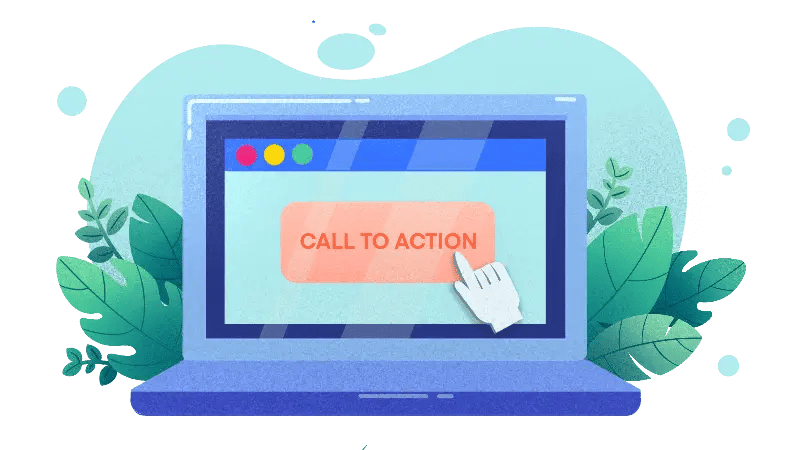Hören Sie auf zu bloggen und beginnen Sie, Leads zu generieren
Blog-Inhalte sind unerlässlich, um Besucher auf Ihre Website zu leiten, unbekannte Besucher zu binden und das Wachstum potenzieller neuer Kunden zu fördern. Richtig gemachtes Blogging hilft allen Unternehmen, online gefunden zu werden, Besucher in Leads umzuwandeln, diese Leads in Verkäufe umzuwandeln und Kunden zu begeistern. Eine solide Content-Marketing-Strategie hilft dabei, eine persönlichere Marke zu etablieren, schafft Vertrauen und ist für eine effektive Inbound-Lead-Generierung unerlässlich. Aber hören Sie auf zu bloggen, nur um mehr Inhalte zu generieren!
Wenn Sie Ihren Blogbeitrag fertiggestellt haben, ist er vielleicht sehr informativ und hat vielleicht sogar einen eingängigen Titel. Ihr Blog enthält relevante und informative Inhalte, die potenzielle Kunden zu schätzen wissen, sich mit ihnen auseinandersetzen und sie hoffentlich teilen. Aber wo ist ein Link zu Ihrer entsprechenden Landing Page? Oder wie wäre es mit einem Call to Action (CTA) am Ende der Seite? Wenn Sie Blogs ohne Konversionsmöglichkeiten schreiben, werden Sie keine Leads generieren.
Fügen Sie eine relevante Handlungsaufforderung ein
Jeder einzelne Blogbeitrag muss mindestens einen CTA enthalten. Ihre Leser sollten in Ihrem Blog einen Call-to-Action haben, einschließlich Abonnements und einer Möglichkeit, Sie zu kontaktieren. Ein CTA trägt dazu bei, ein Gefühl der Dringlichkeit zu vermitteln. Er muss leicht zu finden und verlockend zum Anklicken sein. Sie möchten nicht, dass Ihr Leser sich abmüht, weitere Informationen zu finden. Sie können Ihre CTA oben auf der Seite, unten, innerhalb des Blogbeitrags, in einer Seitenleiste oder als schwebendes/rollendes Popup platzieren. Bei längeren Artikeln können Sie sogar zwei bis drei CTAs verwenden. Denken Sie nur daran: Ohne mindestens einen verlieren Sie potenzielle Kunden.
Erleichtern Sie das Lead Nurturing
Ihre Blogs können den Lead-Nurturing-Prozess unterstützen. Was ist Lead Nurturing? Lead Nurturing bedeutet, Beziehungen zu potenziellen Kunden aufzubauen und sie in ihrer jeweiligen Phase durch den gesamten Kaufprozess zu begleiten. Machen wir uns nichts vor: Mehr als die Hälfte Ihrer CRM-Leads sind nicht bereit, Ihre Dienstleistung oder Ihr Produkt zu kaufen. Beispiel...
Sie beginnen Ihr erstes Date nicht mit der Frage: "Willst du mich heiraten?". Warum sollte das im Vertrieb funktionieren? Dennoch beginnen so viele Ansätze mit einem"Wir können Ihnen X zu reduzierten Preisen anbieten".....
Welche informativen Materialien können Sie Ihren Interessenten zu Beginn schicken, Leitfäden, die Fragen zu den geschäftlichen Problemen beantworten, mit denen sie konfrontiert sind, was Ihre Lösung für sie wertvoll macht und warum sie sich für eine Zusammenarbeit mit Ihnen und nicht mit einem Mitbewerber entscheiden könnten? Bieten Sie Ihren Leads ansprechende, relevante und zielgerichtete Inhalte, die genau widerspiegeln, wo sich der Käufer auf seinem Weg zum Ziel befindet.
Sie möchten keine irrelevanten Informationen versenden, die in der aktuellen Phase des Kaufprozesses nicht hilfreich sind oder nicht ansprechen. Beachten Sie während der gesamten Buyer's Journey die drei Hauptphasen: die Bewusstseinsphase, die Überlegungsphase und die Entscheidungsphase.
Bewusstseinsstufe
Der allererste Schritt in der Buyer's Journey ist die Bewusstseinsstufe. In der Bewusstseinsphase hat ein potenzieller Neukunde ein Bedürfnis nach einem Produkt oder einer Dienstleistung. Höchstwahrscheinlich suchen sie in Google nach Schlüsselwörtern und Begriffen, um sich über ihre Probleme zu informieren. Hier ist eine wirksame SEO-Strategie von entscheidender Bedeutung. In dieser Phase ist es wichtig, den Kunden aufzuklären und zu zeigen, dass Sie mit dem Problem vertraut sind und mögliche Lösungen kennen. Veröffentlichungen in dieser Phase bieten Bildungsinhalte, E-Guides und E-Books, White Papers und relevante Analystenberichte der Branche.
Tipp: Erstellen Sie Bildungsinhalte, die sich mit den Problemen Ihrer Zielgruppe befassen.
Dazu gehören Blogbeiträge, Artikel, Infografiken, Videos oder Webinare. Verwenden Sie bei der Erstellung dieser Inhalte Schlüsselwörter und Ausdrücke, nach denen Ihre Zielgruppe wahrscheinlich suchen wird.
Beispiel: Angenommen, Sie sind ein Unternehmen, das Software für kleine Unternehmen verkauft. Sie könnten Schulungsinhalte erstellen, die sich mit den Problemen von Kleinunternehmern befassen, z. B. wie sie ihre Finanzen verwalten, ihr Unternehmen vermarkten oder Mitarbeiter einstellen können. Sie könnten diese Inhalte in Ihrem Blog, in den sozialen Medien oder in Ihrem E-Mail-Newsletter veröffentlichen.
Durch die Erstellung von Bildungsinhalten, die sich direkt mit den Problemen Ihrer Zielgruppe befassen, können Sie ihnen helfen, ihre Probleme zu verstehen und ihnen mögliche Lösungen anbieten. Damit positionieren Sie sich als Experte auf Ihrem Gebiet und bauen Vertrauen bei Ihrer Zielgruppe auf.
Überlegungsphase
Der zweite Schritt der Buyer's Journey ist die Überlegungsphase. In dieser Phase hat der Käufer seine Ziele und Prioritäten besser definiert und prüft verschiedene Optionen. Sie stellen relevante Informationen zur Verfügung und helfen dabei, die zu treffenden Entscheidungen zu definieren. Die Erstellung von Inhalten für die Interessenten in der Überlegungsphase ist entscheidend, um hilfreich zu sein. Ihre Inhalte umfassen Leitfäden oder Produktvergleiche, Videos oder Podcast-Interaktionen oder Expertenratschläge.
Tipp: Erstellen Sie Inhalte, die Ihrer Zielgruppe helfen, verschiedene Optionen zu vergleichen.
Diese Inhalte können in Form von Blogbeiträgen, Infografiken, Videos oder Vergleichstabellen erstellt werden. Achten Sie bei der Erstellung dieser Inhalte darauf, dass Sie Ihr Produkt oder Ihre Dienstleistung mit der Konkurrenz vergleichen und die Vorteile Ihres Produkts oder Ihrer Dienstleistung hervorheben.
Beispiel: Nehmen wir an, Sie sind ein Unternehmen, das Software für kleine Unternehmen verkauft. Sie könnten Inhalte erstellen, die Ihre Software mit der der Konkurrenz vergleichen. In diesem Inhalt könnten Sie die Funktionen und Vorteile Ihrer Software hervorheben und erklären, wie Ihre Software kleinen Unternehmen zum Erfolg verhelfen kann. Sie könnten diese Inhalte in Ihrem Blog, in den sozialen Medien oder in Ihrem E-Mail-Newsletter veröffentlichen.
Indem Sie Inhalte erstellen, die Ihrem Publikum helfen, verschiedene Optionen zu vergleichen, können Sie ihm helfen, eine fundierte Entscheidung darüber zu treffen, welches Produkt oder welche Dienstleistung das Richtige für es ist. So können Sie mehr Leads in Kunden umwandeln.
Entscheidungsphase
Der dritte und letzte Schritt in der Buyer's Journey ist die Entscheidungsphase. In dieser Phase hat der Käufer eine Lösung für sein Problem gefunden. Er ist jedoch noch auf der Suche nach konkreten Schritten zur Umsetzung, nach den Auswirkungen und Vorteilen der Entscheidung und nach einem vertrauenswürdigen Partner, der ihn bei der Beschaffung oder Umsetzung der Lösung unterstützt. Der Käufer verbringt die meiste Zeit damit, die beste Option zu recherchieren und zu vergleichen. Hilfreiche Inhalte versorgen Ihren potenziellen Neukunden mit Unternehmens- oder Produktvergleichen, Fallstudien, Implementierungsleitfäden und kostenlosen Testversionen, um die endgültige Entscheidungsfindung zu unterstützen.
Tipp: Erstellen Sie Inhalte, die Ihrer Zielgruppe helfen, eine Entscheidung zu treffen.
Diese Inhalte können in Form von Blogbeiträgen, Infografiken, Videos oder Fallstudien erstellt werden. Heben Sie bei der Erstellung dieser Inhalte die Vorteile Ihres Produkts oder Ihrer Dienstleistung hervor und erklären Sie, wie Ihr Produkt oder Ihre Dienstleistung Ihrer Zielgruppe helfen kann, ihre Ziele zu erreichen.
Beispiel: Nehmen wir an, Sie sind ein Unternehmen, das Software für kleine Unternehmen verkauft. Sie könnten Inhalte erstellen, die kleinen Unternehmen bei der Entscheidung helfen, welche Software sie kaufen sollten. In diesem Inhalt könnten Sie die Vorteile Ihrer Software hervorheben und erklären, wie Ihre Software kleinen Unternehmen zum Erfolg verhelfen kann. Sie könnten diese Inhalte in Ihrem Blog, in den sozialen Medien oder in Ihrem E-Mail-Newsletter veröffentlichen.
Indem Sie Inhalte erstellen, die Ihrer Zielgruppe bei der Entscheidung helfen, können Sie sie bei der Wahl Ihres Produkts oder Ihrer Dienstleistung unterstützen. So können Sie mehr Leads in Kunden umwandeln.
 Herzlichen Glückwunsch, Sie haben es bis zur letzten Phase der Buyer's Journey geschafft und sind so kurz davor, einen neuen Kunden zu gewinnen. Da die meisten Nutzer sich nicht bei ihrem ersten Besuch auf Ihrer Website für Ihr Produkt oder Ihre Lösung anmelden, besteht eine große Chance zur Aufrechterhaltung oder Steigerung Ihrer Konversionsraten darin, potenzielle Kunden zurückzuholen, um sie als neue Kunden zu gewinnen.
Herzlichen Glückwunsch, Sie haben es bis zur letzten Phase der Buyer's Journey geschafft und sind so kurz davor, einen neuen Kunden zu gewinnen. Da die meisten Nutzer sich nicht bei ihrem ersten Besuch auf Ihrer Website für Ihr Produkt oder Ihre Lösung anmelden, besteht eine große Chance zur Aufrechterhaltung oder Steigerung Ihrer Konversionsraten darin, potenzielle Kunden zurückzuholen, um sie als neue Kunden zu gewinnen.
Erinnern Sie einen potenziellen Neukunden daran, warum er Ihre Website überhaupt besucht hat. Retargeting oder Remarketing mit (bezahlter) Werbung, sozialen Medien oder E-Mail-Follow-ups müssen einen Besucher zum Wiederkommen verlocken und anregen.
Umstellung
Der Schlüssel zu einem Blog-Post ist es, einen anonymen Besucher zu einer bekannten Person zu machen, die zu neuen Abonnenten, Käufern, die Ihre Inhalte teilen und lesen, und schließlich zum Kauf oder Wiederkauf Ihres Produkts oder Ihrer Dienstleistung führt. Ziel ist es, dass Ihre Inhalte den Weg zum Kunden in verschiedenen Formen, Kanälen und Seiten auf Ihrer Website veranschaulichen. Leiten Sie Ihre Leser an, Antworten auf ihre spezifischen Fragen zu finden. Passen Sie Ihre Inhalte an eine bestimmte Buyer Persona an und interagieren Sie mit ihr, indem Sie ihr etwas Wertvolles und Einzigartiges bieten.
Worauf warten Sie also noch?
Fangen Sie an, Ihren Blog zu schreiben, aber nicht nur, um mehr Inhalte zu erstellen. Nutzen Sie Ihren Blog, um Leads zu generieren!
Wählen Sie die Themen, über die Sie schreiben möchten, strategisch aus, und entwickeln Sie eine Content-Strategie, bevor Sie Ihren ersten Blogbeitrag schreiben.
Erstellen Sie Inhalte, die alle Phasen der Buyer's Journey und der Persona ansprechen, und machen Sie sie persönlich und ansprechend. Fügen Sie jedem Blog-Beitrag einen oder mehrere CTAs hinzu. Befolgen Sie diese einfachen Schritte und beobachten Sie, wie Ihre Website zu einem wichtigen Treiber für Leads für Ihr Unternehmen wird.
Dieser Beitrag ist auch verfügbar in:
- Englisch: Stop Blogging & Start Generating Leads
- Spanisch: Deje de bloguear y empiece a generar clientes potenciales
- Französisch: Arrêtez de bloguer et commencez à générer des prospects
- Italienisch: Smettere di bloggare e iniziare a generare contatti
- Rumänisch: Nu mai scrie pe blog și începe să generezi clienți potențiali
- Chinesisch: 停止写博客,开始创造商机








.webp?width=352&name=Negative%20buyer%20personas%20AM%20(1).webp)

Hinterlasse einen Kommentar